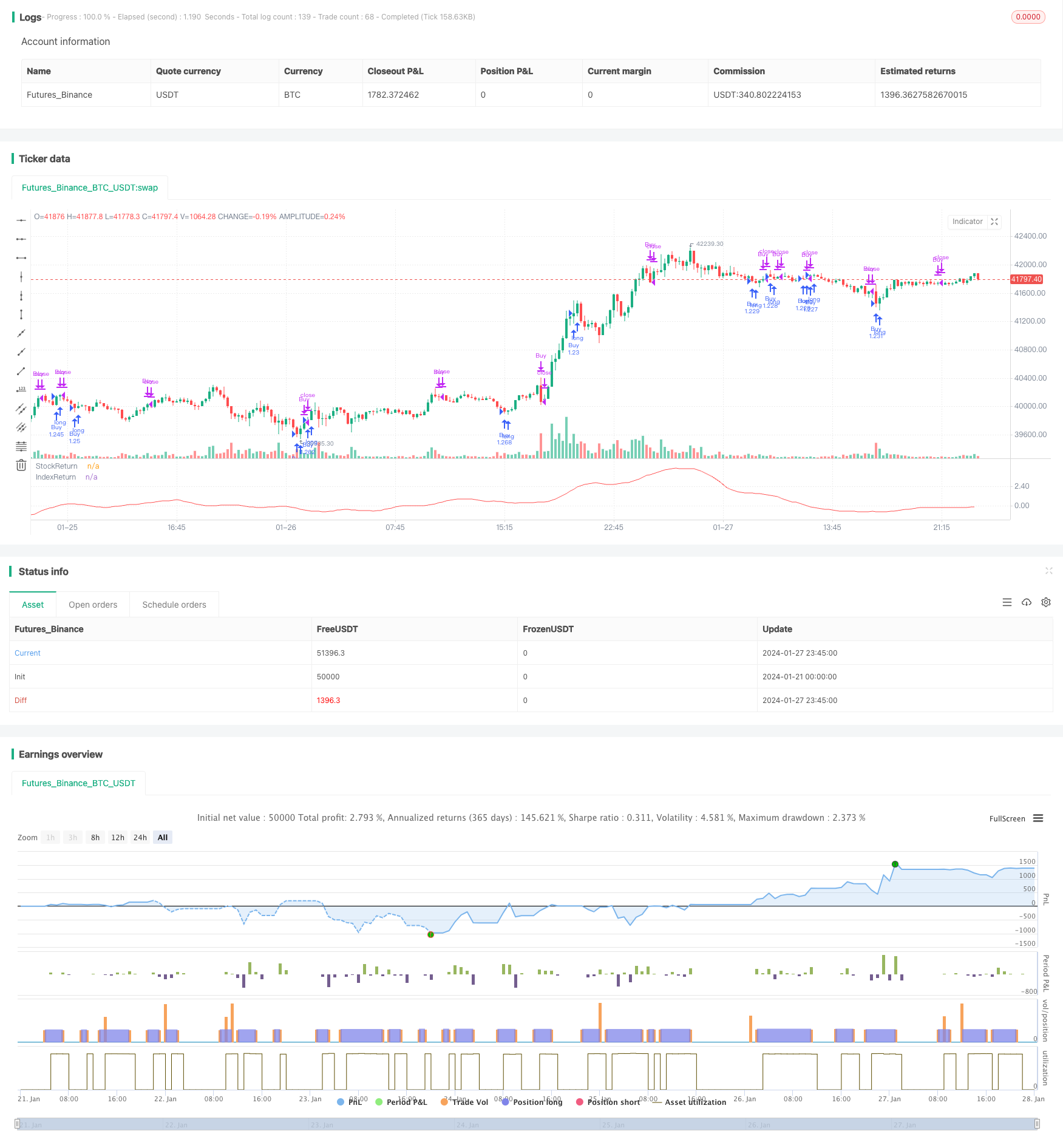
概述
相对动量策略通过比较个股和指数的动量,来判断个股相对于大盘的强弱,当个股的动量高于大盘时买入,个股动量低于大盘时卖出,以捕捉个股的增长高峰。
策略原理
该策略主要判断个股相对大盘的强弱,具体逻辑是:
- 计算个股在某段时间内的收益率作为个股动量
- 计算指数在同一段时间内的收益率作为指数动量
- 将个股动量和指数动量计算移动平均线平滑处理
- 当个股动量的移动平均线上穿指数动量的移动平均线时,认为个股动量强于指数整体,成为买入信号
- 当个股动量的移动平均线下穿指数动量的移动平均线时,认为个股动量弱于指数整体,成为卖出信号
通过这样的逻辑判断,我们可以买入个股增长旺盛的时期,并在其增长动力消退时及时卖出,锁定其增长高峰期的超额收益。
优势分析
相对动量策略主要具有以下优势:
- 可动态捕捉个股增长高峰,无需关心具体行情,只要个股增长快于大盘即可买入
- 通过移动平均线处理,可过滤掉短期波动的干扰,增强信号的可靠性
- 简单直接的买入卖出条件,容易理解操作
- 可自由设定计算相对动量的时间参数,优化策略
风险分析
相对动量策略也存在一定的风险:
- 个股增长高峰结束后可能出现回调调整,存在止盈不足的风险
- 相对动量指标可能产生错误信号,识别的增长高峰并非真实高峰
- 需设置止损来控制最大亏损
这些风险可以通过合理止盈止损、适当调整参数等方法来控制。
优化方向
相对动量策略可从以下几个方面进行优化:
- 测试不同的动量计算时间参数,找到最佳参数
- 测试不同类型和长度的移动平均线,寻找最优参数
- 加入成交量指标过滤,避免量能不足的假突破
- 结合其他技术指标确认买入时机
总结
相对动量策略通过捕捉个股相对大盘的增长高峰,可有效获取超额收益。该策略具有简单清晰的买入卖出逻辑、易于操作的优点,通过参数优化和风险控制,可获得较好的效果。
策略源码
/*backtest
start: 2024-01-21 00:00:00
end: 2024-01-28 00:00:00
period: 15m
basePeriod: 5m
exchanges: [{"eid":"Futures_Binance","currency":"BTC_USDT"}]
*/
// This source code is subject to the terms of the Mozilla Public License 2.0 at https://mozilla.org/MPL/2.0/
// © HeWhoMustNotBeNamed
//@version=4
strategy("Relative Returns Strategy", overlay=false, initial_capital = 100000, default_qty_type = strategy.percent_of_equity, default_qty_value = 100, commission_type = strategy.commission.percent, pyramiding = 1, commission_value = 0.01, calc_on_order_fills = true)
index_ticker=input("BTC_USDT:swap")
Loopback = input(40, step=20)
useStopAndIndexReturns = input(true)
useStopAndIndexReturnsMa = input(true)
useDifference = not useStopAndIndexReturns
MAType = input(title="Moving Average Type", defval="sma", options=["ema", "sma", "hma", "rma", "vwma", "wma"])
MALength = input(10, minval=10,step=10)
i_startTime = input(defval = timestamp("01 Jan 2010 00:00 +0000"), title = "Backtest Start Time", type = input.time)
i_endTime = input(defval = timestamp("01 Jan 2099 00:00 +0000"), title = "Backtest End Time", type = input.time)
inDateRange = true
f_secureSecurity(_symbol, _res, _src, _offset) => security(_symbol, _res, _src[_offset], lookahead = barmerge.lookahead_on)
f_getMovingAverage(source, MAType, length)=>
ma = sma(source, length)
if(MAType == "ema")
ma := ema(source,length)
if(MAType == "hma")
ma := hma(source,length)
if(MAType == "rma")
ma := rma(source,length)
if(MAType == "vwma")
ma := vwma(source,length)
if(MAType == "wma")
ma := wma(source,length)
ma
index = f_secureSecurity(index_ticker, '1D', close, 0)
stock_return = (close - close[Loopback])*100/close
index_return = (index - index[Loopback])*100/index
stock_return_ma = f_getMovingAverage(stock_return, MAType, MALength)
index_return_ma = f_getMovingAverage(index_return, MAType, MALength)
relativeReturns = stock_return - index_return
relativeReturns_ma = f_getMovingAverage(relativeReturns, MAType, MALength)
plot(useStopAndIndexReturns ? useStopAndIndexReturnsMa ? stock_return_ma : stock_return : na, title="StockReturn", color=color.green, linewidth=1)
plot(useStopAndIndexReturns ? useStopAndIndexReturnsMa ? index_return_ma : index_return : na, title="IndexReturn", color=color.red, linewidth=1)
plot(useDifference?relativeReturns:na, title="Relative-Returns", color=color.blue, linewidth=1)
plot(useDifference?relativeReturns_ma:na, title="MA", color=color.red, linewidth=1)
buyCondition = (useStopAndIndexReturns ? useStopAndIndexReturnsMa ? stock_return_ma > index_return_ma : stock_return > index_return : relativeReturns > relativeReturns_ma)
closeBuyCondition = (useStopAndIndexReturns ? useStopAndIndexReturnsMa ? stock_return_ma < index_return_ma : stock_return < index_return : relativeReturns < relativeReturns_ma)
strategy.entry("Buy", strategy.long, when=buyCondition and inDateRange, oca_name="oca")
strategy.close("Buy", when=closeBuyCondition)